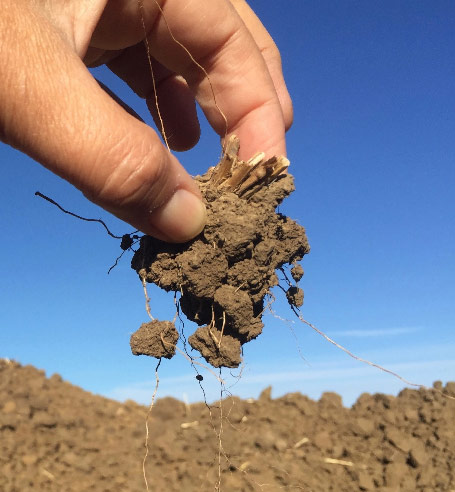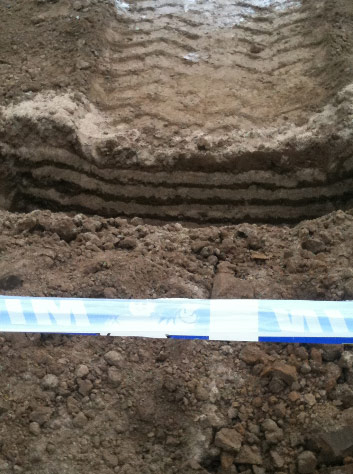Background
Soil structure refers to the arrangement of mineral and organic soil particles and the spaces between them.1 Soil structure in a healthy soil allows for both movement and retention of water and nutrients, as well as providing space for root growth. Structural degradation of the soil most commonly refers to compaction, the compression of soil particles so that the space between them is diminished (especially large pores), but can also refer to the lack of cohesion that occurs in sandy soils. Compacted soils can result in ponding and limited root growth, while non-cohesive soils can drain too quickly and result in erosion, water and nutrient loss.
Soil particles can be bound together in many ways, by biological processes such as root growth, mineral factors such as interactions between clay particles, and substances that act like “glues” such as calcium, iron, and microbial byproducts2. Once bound together, these soil particles form structures called aggregates, while the air and water-filled spaces between aggregates are referred to as pores. The interconnected network of air and water filled pores in the soil has a large effect on crop production, as it affects root penetration, water storage, and the movement of organic and inorganic substances.3 Aggregates also affect the soil microbial community by providing habitats for growth, and by protecting soil carbon from decomposition.

Image of a soil aggregate held together by roots.
Image © 2017 Kate Scow.
Soil structure naturally disintegrates and re-forms as soil microbes consume organic carbon and produce microbial “glues”.2 This process can be disrupted through tillage and intensive agricultural activity, which breaks apart aggregates4. Over time, as soil organic carbon is depleted, the regeneration of soil structure after a tillage event can be greatly reduced, resulting in structure degradation.
Diagnosis
Degraded soil structure can be diagnosed through use of a penetrometer, or through field observations.
- A penetrometer is a tool used to detect surface or subsoil compaction by measuring the amount of force needed to push a steel probe into the ground.
- Field observations of poor soil structure can include noting difficulty while tilling or digging, observations of crusting, dense horizontal soil layers or lateral root growth when soil is scraped away with a shovel. Soil aggregates can also be hand-crushed to get an idea of compaction levels.
- Aggregate slaking measures the breakdown of large air-dried soil aggregates when immersed in water. Soil with good structure will hold together upon submersion better than soil with poor structure. This test gives an idea of a soil’s capacity to sustain its structure during a rainfall event.

An image of soil compaction from tractor tires.
Taken from https://commons.wikimedia.org/wiki/File:Soil_compaction.JPG
Management
Methods to improve soil structure can involve minimizing the amount of disturbance that occurs, while providing energy sources for microbes to re-form soil aggregates.
- Tillage Management - Tillage has many benefits, from aerating the soil, to reducing weed populations, to aiding with distribution of soil amendments. While tillage can be an effective tool when used carefully, overtillage can cause the destruction of soil structure, compaction, erosion, and the need for more extreme tillage practices to compensate. “Conservation Agriculture (CA)” is a set of tillage practices that minimize disturbances to soil structure, composition, and natural biodiversity. There are many practices that fall under this CA category, including “conservation tillage” which reduces tillage intensity and retains crop residues, and “zero tillage” which aims to grow crops without disturbing the soil through tillage at all.
- Strategies to avoid falling into the overtillage negative feedback loop include:
- Delaying tillage until the soil is dry enough - Tilling while the soil is too wet can result in compaction and the formation of soil clods.
- Minimize impact - If tilage needs to occur in less than ideal moisture conditions, minimizing axle loads on tractors, ensuring properly inflated and sized tires, and planning clear paths for tractors to travel can help minimize impact.
- Choosing the right type of tillage - Fine-tuning the amount of tillage required by managing the number and depth of passes and using direct seeding can help improve both soil structure and organic carbon sequestration in soils. There are several different methods to choose from with a host of benefits and drawbacks, including zero tillage, reduced tillage, and ridge tillage. Farmers should aim to use the tillage methods that work best for their region.
- Increase soil organic matter - Increasing soil organic matter provides a food source for microbes, which can aid in the regeneration of soil structure. Increasing organic matter can also help increase nutrient retention, infiltration rates, and water storage in loosely packed soils.
- See section on low organic matter for additional resources.
- Crop management - Soil structure can be managed using crops with different rooting depth and rooting types (taproots can aid in breaking up compacted soil) as well as increasing soil organic matter content.
References
- Lal, Rattan. 1991. “Soil Structure and Sustainability.” Journal of Sustainable Agriculture 1(4): 67–92. http://www.tandfonline.com/doi/abs/10.1300/J064v01n04_06 (August 14, 2018).
- Six, J., E. T. Elliott, and K. Paustian. 2000. “Soil Macroaggregate Turnover and Microaggregate Formation: A Mechanism for C Sequestration under No-Tillage Agriculture.” Soil Biology and Biochemistry.
- Lipiec, J., J. KuÅ›, A. SÅ‚owiÅ„ska-Jurkiewicz, and A. Nosalewicz. 2006. “Soil Porosity and Water Infiltration as Influenced by Tillage Methods.” Soil and Tillage Research 89(2): 210–20. https://www.sciencedirect.com/science/article/pii/S0167198705002175 (August 19, 2018).
- Bronick, C.J., and R. Lal. 2005. “Soil Structure and Management: A Review.” Geoderma 124(1–2): 3–22. https://www.sciencedirect.com/science/article/pii/S0016706104000898 (August 19, 2018).
Resources
Assessment Methods for Soil Structure
- A website explaining the process of aggregate slaking and offering video demonstrations http://soilquality.org/indicators/slaking.html
- Guidelines for the Visual Assessment of Soil Structure from the Scottish Rural College https://www.sruc.ac.uk/info/120625/visual_evaluation_of_soil_structure
- Description of soil structure and methods of assessment from the government of Tasmania http://soilquality.org.au/factsheets/soil-structure
- Guidelines on how to use and interpret results from a penetrometer by Pennsylvania State University https://extension.psu.edu/diagnosing-soil-compaction-using-a-penetrometer-soil-compaction-tester
- A presentation encompassing the definition of soil structure and methods to reduce soil structure degradation by Cranfield University http://www.smartagriplatform.com/resources/Documents/Rickson%20-%20Managing%20soils%20for%20profit%20and%20restoration%20-%20
Wellbeck_Feb2016.pdf
Soil Compaction
- Summary of the effects of soil compaction by Pennsylvania State Extension service https://extension.psu.edu/effects-of-soil-compaction
- A review of the economic costs and factors behind soil compaction https://researcharchive.lincoln.ac.nz/bitstream/handle/10182/4916/soil_compaction_and_farm.pdf?sequence=3
- Guidelines to understanding and managing soil compaction by the Agriculture Research Division of Alberta, Canada https://www1.agric.gov.ab.ca/$department/deptdocs.nsf/all/agdex13331/$file/510-1.pdf?OpenElement
- Summary of soil compaction, consequences, and strategies for management from the University of Minnesota https://extension.umn.edu/soil-management-and-health/soil-compaction
- Understanding and managing compaction in agricultural fields by New Mexico State University http://aces.nmsu.edu/pubs/_circulars/CR672.pdf
- Guidelines to managing soil compaction from Oklahoma State University http://pods.dasnr.okstate.edu/docushare/dsweb/Get/Document-2638/PSS-2244web2014.pdf
- Causes and cures of soil compaction by the University of Wisconsin http://www.soils.wisc.edu/extension/pubs/A3367.pdf
Tillage Methods
- Resource links from the African Conservation Tillage Network http://www.act-africa.org/library.php?com=5
- A guide to Soil Management and Tillage by the University of Illinois http://extension.cropsciences.illinois.edu/handbook/pdfs/chapter10.pdf
- A short description of conservation tillage methods by Purdue University https://www.extension.purdue.edu/extmedia/ct/ct-1.html
- A summary of conservation tillage methods done by the University of California SAREP Program http://asi.ucdavis.edu/programs/sarep/about/copy_of_what-is-sustainable-agriculture/practices/conservation-tillage
- An open source paper outlining conservation tillage impacts on soil and the environment https://www.sciencedirect.com/science/article/pii/S2095633915300630
- A report on changes to soil resources in Sub-Saharan Africa by the FAO http://www.fao.org/3/a-bc598e.pdf
- A report on changes to soil resources in Asia by the FAO http://www.fao.org/3/a-bc599e.pdf
- Standards of practice for conservation tillage by the USDA and NRCS https://www.nrcs.usda.gov/Internet/FSE_DOCUMENTS/stelprdb1254982.pdf
- Tips for ridge tillage by the University of Missouri https://extension2.missouri.edu/g1652
- Advantages and disadvantages of Ridge tillage by the University of Kentucky https://uknowledge.uky.edu/cgi/viewcontent.cgi?article=1042&context=pss_views
- Scientific paper outlining zero-tillage strategies https://www.sciencedirect.com/science/article/pii/S0065211308607798
- Guide on implementing zero tillage management from India http://www.knowledgebank.irri.org/images/docs/reduced-and-zero-tillage-options.pdf
- Short summary of different tillage options by the FAO http://www.fao.org/docrep/006/y5146e/y5146e08.htm
- Guides to Conservation tillage practice and erosion control by the USDA https://www.nal.usda.gov/afsic/conservation-tillage-practices-and-erosion-control
Background on Soil Texture and Structure
- Explanation of soil structure and the pore network by the NRCS http://soilquality.org/indicators/soil_structure.html
- Summary of the principles behind soil structure by the State Government of Victoria, Canada vro.agriculture.vic.gov.au/dpi/vro/vrosite.nsf/pages/soilhealth_soil_structure
- Detailed description of what soil structure means at different depths by a “vertical tillage” company https://www.verticaltillage.com/en/9630/what-affects-soil-structure
- Summary of the principles behind soil structure done by the FAO http://www.fao.org/tempref/FI/CDrom/FAO_Training/FAO_Training/General/x6706e/x6706e07.htm
- Short summary of issues that poor soil structure causes for grassland and rangeland by a British dairy company https://dairy.ahdb.org.uk/technical-information/grassland-management/healthy-grassland-soils/soil-structure/assessing-soil-structure/cost-of-poor-soil-structure/
- A primer on soil texture, structure and compaction by Pennsylvania State University https://extension.psu.edu/soil-quality-information
- An open source review of research into soil structure and management http://citeseerx.ist.psu.edu/viewdoc/download?doi=10.1.1.473.5938&rep=rep1&type=pdf
- A factsheet on mechanisms behind soil compaction https://cdn.ymaws.com/www.asaqs.co.za/resource/resmgr/downloads/Compaction_Classification_Ar.pdf
- A summary of the principles behind soil structure and aggregation from the University of Hawaii at Manoa https://www.ctahr.hawaii.edu/mauisoil/a_factor_ts.aspx
- Short overview of soil structure from Queensland, Australia https://www.qld.gov.au/environment/land/soil/soil-properties/structure
